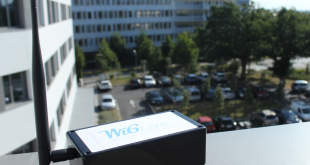The OSO-AI start-up has recently completed a €4 million funding round. Its artificial intelligence solution that can detect incidents such as falls or cries for help has convinced investors, along with a number of nursing homes in which it has been installed. This technology was developed in part through the work of Claude Berrou, a researcher at IMT Atlantique, and …
Read More »Search Results for: home network
CiViQ: working towards implementing quantum communications on our networks
End 2018, the CiViQ H2020 European project was launched for a period of three years. The project aims to integrate quantum communication technologies into traditional telecommunication networks. This scientific challenge calls upon Télécom Paris’ dual expertise in both quantum cryptography and optical telecommunication, and will provide more security for communications. Romain Alléaume, a researcher in quantum information, is a member …
Read More »Smart homes: A world of conflict and collaboration
The progress made in decentralized artificial intelligence means that we can now imagine what our future homes will be like. The services offered by a smart home to its users are likely to be modeled on appliances which communicate and cooperate with each other autonomously. Today, this approach is considered the best way to control the dynamic, data-rich household environment. …
Read More »Wi6labs: customized sensor networks
Wi6labs, a start-up incubated at IMT Atlantique, installs connected sensor networks for municipalities and industries. What makes this startup so unique? It offers custom-developed private networks that are easy to install. When it comes to controlling energy networks, water supply and monitoring air quality, the solution proposed by Wi6labs is attractive due to its simplicity and the savings it offers. …
Read More »EUROP: Testing an Operator Network in a Single Room
The next article in our series on the Carnot Télécom technology platforms and digital society, with EUROP (Exchanges and Usages for Operator Networks) at Télécom Saint-Étienne. This platform offers physical testing of network configurations, to meet service providers’ needs. We discussed the platform with its director, Jacques Fayolle, and assignment manager Maxime Joncoux. What is EUROP? Jacques Fayolle: The …
Read More »From epertise in telecommunications networks to the performance of electricity grids
From networks to everyday objects, the internet has radically changed our environment. From the main arteries to the smallest vessels, it is embedded in such a large number of the most banal objects that it puts a strain on the energy bill. Yet now communicating objects can exchange information to optimize their electricity consumption. After several years of research on …
Read More »Debate: The Metaverse, flying taxis and other weapons of mass planetary destruction
Fabrice Flipo, Institut Mines-Télécom Business School 5G, 8K, flying taxis and the Metaverse are all topics of great interest, raising many questions. However, such questions are rarely, if ever, from an environmental perspective. A recent article from French daily newspaper Le Monde, published October 18 2021 and titled “Facebook to hire 10,000 people in Europe to create the Metaverse”, discusses …
Read More »Improving air quality with decision-making tools
Launched in October for a four-year period, the RI-URBANS project aims to strengthen synergies between European air quality monitoring networks and research infrastructures in the field of atmospheric sciences. IMT Nord Europe is a partner for this project, which received up to €8 million of funding from the European Union. Interview with Stéphane Sauvage, professor, and Thérèse Salameh, R&D engineer. European project …
Read More »What is digital sufficiency?
Digital consumption doubles every 5 years. This is due in particular to the growing number of digital devices and their increased use. This consumption also has an increasing impact on the environment. Digital sufficiency refers to finding the right balance for the use of digital technology in relation to the planet and its inhabitants. Fabrice Flipo, a researcher at Institut Mines-Télécom …
Read More »Making algorithms understand what we are talking about
Human language contains different types of information. We understand it all unconsciously, but explaining it systematically is much more difficult. The same is true for machines. The NoRDF Project Chair “Modeling and Extracting Complex Information from Natural Language Text” seeks to solve this problem: how can we teach algorithms to model and extract complex information from language? Fabian Suchaneck and Chloé Clavel, both …
Read More » I'MTech L'actualité scientifique et technologique de l'IMT
I'MTech L'actualité scientifique et technologique de l'IMT









